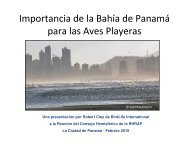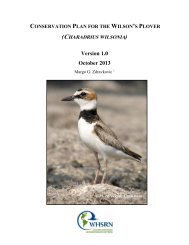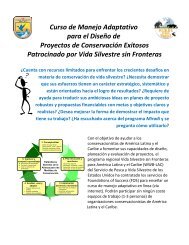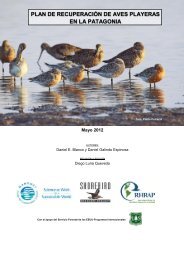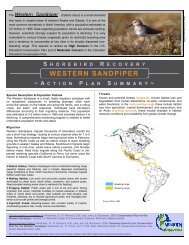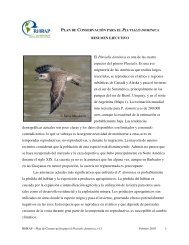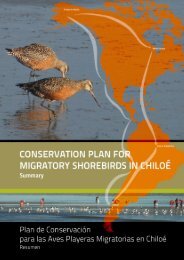Sanderling Plan - Western Hemisphere Shorebird Reserve Network
Sanderling Plan - Western Hemisphere Shorebird Reserve Network
Sanderling Plan - Western Hemisphere Shorebird Reserve Network
You also want an ePaper? Increase the reach of your titles
YUMPU automatically turns print PDFs into web optimized ePapers that Google loves.
Educational messages<br />
Educational content should inform viewers about the <strong>Sanderling</strong>, and cover the ecological<br />
basics, such as:<br />
o <strong>Sanderling</strong>s require specific habitats to complete their life cycle (e.g., beaches,<br />
shallow lakes);<br />
o There are three critical phases in a <strong>Sanderling</strong>’s lifecycle when specific habitat needs<br />
must be met: breeding, staging (migratory), and nonbreeding (wintering);<br />
o Many <strong>Sanderling</strong> habitats currently face threats from habitat loss and degradation,<br />
such as from agricultural and urban development, and human disturbance.<br />
Educational messages should convey the need for adequate food and resting resources<br />
during migration and winter, such as the need for adequate and ecologically healthy populations<br />
of Horseshoe Crabs in the mid-Atlantic region (the crab eggs are a key food source during spring<br />
migration). Due to their reliance on sandy beach habitat and sensitivity to various stressors,<br />
<strong>Sanderling</strong>s are good indicators (i.e., umbrella species) for monitoring the health of coastal<br />
ecosystems, and the affects of global climate change.<br />
Educational messages should also seek to inspire viewers about <strong>Sanderling</strong>s (e.g., via<br />
their spectacular migrations), build public interest and compassion, and embody positive human<br />
values. Some examples are provided in the Regional <strong>Shorebird</strong> <strong>Plan</strong>s (e.g., Drut and Buchanan<br />
2000, Hickey et al. 2003, and others; see U.S. <strong>Shorebird</strong> Conservation <strong>Plan</strong> website). Other<br />
useful language and perspectives on caring for wildlife (i.e., managing wildlife as a legacy) are<br />
outlined in the State Wildlife Action <strong>Plan</strong> overview (on the Internet). Appropriate metaphors can<br />
be powerful tools for drawing-in additional public interest or for shifting public attitude towards<br />
wildlife; for example, <strong>Sanderling</strong>s are elite athletes and experienced globe-trotters, members of<br />
the ‘global economy’ long before we joined. The parallel between Horseshoe Crabs and sea<br />
turtles is also compelling (since both come ashore in spring tides to breed), as is the notion that<br />
Horseshoe Crabs are ‘living fossils’ (their ancestors dating back before the dinosaurs; Clark and<br />
Niles 2000). Finally, because <strong>Sanderling</strong>s use—and rely upon—habitats that span the entire<br />
<strong>Western</strong> <strong>Hemisphere</strong>, they link people and countries together. Their persistence requires that we<br />
invest in our own future and work together—to reduce pollution and harmful contaminants, to<br />
reduce and contain our human impacts, to address climate change, to ensure that wild areas<br />
WHSRN – <strong>Sanderling</strong> Conservation <strong>Plan</strong>, February 2010, v1.1 53




